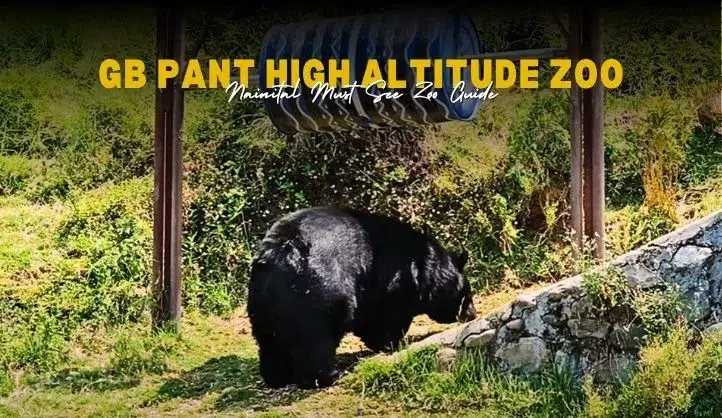The GB Pant High Altitude Zoo is one of the most exciting places to visit in Nainital, a beautiful hill town in Uttarakhand, India. This zoo is not like any regular zoo—it is built high up in the mountains, at about 2,100 meters above sea level. That’s why it’s called a high altitude zoo.
If you love animals, nature, and cool mountain air, then GB Pant Zoo in Nainital is the perfect place for you and your family.
What is the GB Pant High Altitude Zoo?
GB Pant High Altitude Zoo, also known as the Nainital Zoo, is a special place where you can see rare animals that live in cold mountain areas. It was started in 1984 and opened to the public in 1995. The zoo is named after Govind Ballabh Pant, a famous Indian freedom fighter and leader.
This zoo is one of the only three high-altitude zoos in India, and it is very popular with tourists, school groups, and nature lovers.
Why is the GB Pant Zoo Special?
Here are some cool things that make this zoo special:
- It is located on Sher Ka Danda Hill, which gives amazing views of Nainital Lake and the Kumaon hills.
- The zoo is home to rare Himalayan animals like the snow leopard, red panda, Himalayan black bear, and Tibetan wolf.
- It is a clean and green place, with lots of trees and fresh air.
- The zoo helps in saving endangered animals and teaches people about wildlife conservation.
Animals You Can See at GB Pant Zoo
At the GB Pant High Altitude Zoo in Nainital, you’ll find some of the most unique and rare animals from the Himalayan region. Here’s what you can expect to see:
- Royal Bengal Tiger – Strong and majestic, this big cat is one of the zoo’s biggest stars.
- Snow Leopard – A rare and beautiful mountain cat, known for its thick fur and quiet nature.
- Tibetan Wolf – Wild and alert, these wolves are used to cold, rocky places.
- Leopard Cat – A small spotted feline that hides in trees and bushes.
- Himalayan Black Bear – Often seen lounging or climbing, these bears love the cool weather.
- Himalayan Civet – A shy, night-active animal that looks like a cat mixed with a mongoose.
- Barking Deer – These deer actually bark like dogs when they sense danger!
- Goral – A goat-like animal that jumps easily on steep, rocky hills.
- Cheer Pheasant – A rare bird with grey feathers, found only in the Himalayas.
- Kalij Pheasant – With shiny black feathers and red eyes, it’s a showstopper.
- Lady Amherst’s Pheasant – Very colourful, with long tail feathers and a fancy look.
- Golden Pheasant – Bright red, yellow, and gold—like a walking rainbow.
- White Peafowl – A beautiful, all-white version of the peacock.
- Hill Partridge – A small mountain bird that loves to stay hidden in the bushes.
These animals are kept in safe and natural-looking homes inside the zoo. It’s a perfect place to learn about wildlife, click great photos, and enjoy nature at its best.
Best Time to Visit GB Pant Zoo
The best months to visit the zoo are:
- March to June (Spring-Summer): Pleasant weather, clear skies, and active animals make this a perfect time for a zoo visit.
- September to November (Autumn): Crisp air and scenic views of surrounding hills add to the experience—ideal for photos and nature walks.
- July to August (Monsoon): Not recommended due to heavy rain, slippery trails, and reduced visibility.
- December to February (Winter): Very cold and may have snow; while the zoo is open, it’s best for visitors who enjoy chilly climates.
- Best Time of Day: Mornings around 10 AM are ideal—animals are more active, and crowds are fewer.
The zoo is closed on Mondays, so plan your visit on other days.
How to Reach GB Pant High Altitude Zoo
- Location: The zoo is located on Sher Ka Danda Hill, about 2 km from Tallital Bus Stand, Nainital.
- By Foot: You can walk uphill from the bus stand. It’s a short but steep trek, so wear comfortable shoes.
- By Car or Taxi: You can drive or hire a local taxi up to the zoo gate. Parking is available nearby.
- By Ropeway: Take the Nainital Ropeway for a scenic ride and get off near the zoo trail. It offers stunning aerial views of the town.
- Zoo Shuttle Service: A shuttle runs from the India Hotel, Tallital, managed by the local municipality.
Entry Fee and Timings
- 🕘 Timings: 10:00 AM to 4:30 PM (Closed on Mondays)
- 🎟️ Entry Fee:
- Adults: ₹50
- Children (5–12 years): ₹20
- Camera: ₹25
- Video Camera: ₹200
Nearby Attractions Around GB Pant High Altitude Zoo
After visiting the GB Pant High Altitude Zoo, there’s so much more to explore in and around Nainital. Here are some must-visit places nearby that will make your trip even more exciting:
- Naini Lake: Just a short distance from the zoo, Naini Lake, a pear-shaped lake, is the heart of Nainital. You can go boating, take a peaceful walk along the promenade, or simply sit and enjoy the view. In the evening, the lakefront lights up with a musical fountain show—perfect for families and couples.
- Snow View Point: One of the most popular viewpoints in Nainital, Snow View offers breathtaking views of the snow-covered Himalayan peaks. You can reach it by cable car or a short drive. It’s a great spot for photography and enjoying the cool mountain breeze.
- Eco Cave Gardens: Located about 3 km from the zoo, this attraction is a hit with kids and adventure lovers. Walk through natural limestone caves, hanging gardens, and small waterfalls. It’s fun, educational, and a little mysterious!
- Tiffin Top (Dorothy’s Seat): A scenic picnic spot located about 4 km from the zoo. You can trek or ride a horse to the top, where you’ll be rewarded with panoramic views of Nainital town and the surrounding hills. It’s a peaceful place to relax and click some amazing photos.
- Mall Road: The bustling Mall Road is perfect for shopping, eating, and soaking in the local vibe. From woollen clothes and handmade candles to street food and cozy cafés, there’s something for everyone. It’s a great place to unwind after your zoo visit.
- St. John in the Wilderness Church: A quiet and historic church surrounded by tall deodar trees. Built in 1844, it’s one of the oldest buildings in Nainital and offers a peaceful break from the busy tourist spots.
- Naina Devi Temple: Located near Naini Lake, this sacred temple is dedicated to Goddess Naina Devi. It’s a spiritual and cultural stop that many visitors include in their Nainital itinerary.
Why You Should Visit GB Pant Zoo
- It’s perfect for families and kids
- You can learn about animals and their homes
- It’s a great place for school trips and nature walks
- You get to see rare animals in a safe and clean place
- It’s one of the top tourist places in Nainital
Conclusion
GB Pant High Altitude Zoo is not just a zoo—it’s a place full of fun, learning, and nature. Whether you’re a kid, a parent, or a traveller, this zoo will make your trip to Nainital extra special. So pack your bags, grab your camera, and get ready to meet some amazing animals in the heart of the Himalayas!
FAQs
1. Is the GB Pant High Altitude Zoo suitable for elderly visitors?
Yes, but the uphill walk can be challenging. Elderly visitors are advised to use the zoo shuttle service or hire a taxi to reach the entrance comfortably.
2. Are pets allowed inside the zoo?
No, pets are strictly not allowed inside the zoo premises to ensure the safety of both the zoo animals and your pets.
3. Are there any food stalls or cafés inside the zoo?
There is a small Nature Café near the entrance that offers snacks and beverages. However, it’s best to carry your own water and light snacks, especially if visiting with kids.
4. Is photography allowed inside the zoo?
Yes, photography is allowed for personal use. However, professional photography or videography may require prior permission from the zoo authorities.
5. Does the zoo offer guided tours?
While there are no official guided tours, informational boards are placed near each enclosure. Some local tour operators may include the zoo in their Nainital sightseeing packages.
6. What kind of trees and plants can be seen in the zoo?
The zoo is surrounded by evergreen oak, cypress, and rhododendron trees, creating a cool and forested environment that mimics the animals’ natural habitat.





